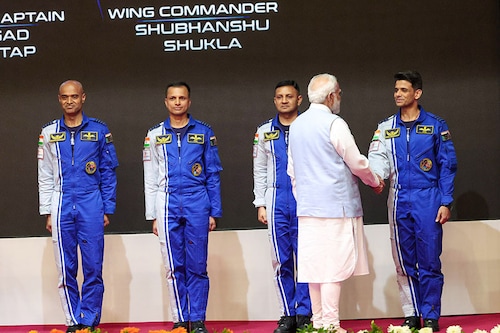Explained: India's Gaganyaan mission
Prime Minister Narendra Modi revealed the names of the astronauts selected for India's first crewed space mission. Here's a low-down on the programme, the chosen astronauts, their training, and potent


On August 23, 2023, Indian became the first nation in the world to successfully perform a soft landing on the lunar south pole with Chandrayaan-3. In another first, the Indian Space Research Organisation (ISRO) is gearing up for its first crewed Indian space mission, Gaganyaan.
During his trip to the Vikram Sarabhai Space Centre in Thiruvananthapuram, Kerala, Prime Minister Narendra Modi on Tuesday announced the names of the astronauts set to crew the spacecraft, all of whom hold ranks as either wing commanders or group captains in the Indian Air Force (IAF) and boast significant experience as test pilots.
The Gaganyaan project aims to send a team of astronauts into space, orbiting 400 km above Earth for a three-day mission, and safely return them by landing in the Indian Ocean. According to ISRO, the key elements needed for the Gaganyaan mission include developing critical technologies like a safe launch vehicle for astronauts, a life support system to keep them comfortable in space, a way for the crew to escape in case of emergency, and plans for their training, recovery, and medical care.
ISRO has been conducting various tests in preparation for the upcoming mission, and in a significant one which took place in October last year, they successfully demonstrated the crew"s ability to safely evacuate the rocket in the event of a malfunction. Following this achievement, the space agency announced plans for a test flight in 2024, where a robot will be sent into space, paving the way for human astronauts to embark on their journey in 2025.
The Gaganyaan project, named after the Sanskrit term for a vehicle to the sky, has been developed with an investment of $1 billion, according to the BBC. Its success would mark India as the fourth nation to achieve human spaceflight capability, following Russia, the US and China.
The renowned Indian LVM3 rocket, previously utilised for the Chandrayaan-3 mission, will serve as the launch vehicle for the Gaganyaan mission. It comprises solid, liquid and cryogenic stages. All systems within the LVM3 launcher are being reconfigured specifically for the mission to meet human requirements, now designated as the Human Rated LVM3 (HLVM3). According to ISRO, HLVM3 will have the capability to launch the Orbital Module into the intended Low Earth Orbit of 400 km.
The prime minister announced the names of the astronauts who are a part of the Gaganyaan mission, during an event held in Thiruvananthapuram, where the four officers were hailed as "dreamers, adventurers, and courageous individuals preparing for space exploration". Hailing from the Indian Air Force, they are Group Captain Prashanth Balakrishnan Nair, Group Captain Ajit Krishnan, Group Captain Angad Pratap, and Wing Commander Shubhanshu Shukla. Only three of these four pilots will eventually go to space as part of the mission.
Prime Minister Modi and ISRO chief S Somanath adorned their shirts with badges featuring golden wings, with the former calling them "India"s pride". The chosen men are Air Force pilots who have been selected after undergoing extensive physical and psychological evaluations. Having completed a rigorous , 13-month training in Russia, they are now continuing their training in India.
Accorsing to ISRO, ensuring human safety is the top priority for the Gaganyaan mission. To achieve this goal, a range of new technologies, including engineering systems and human-centric systems, are being developed and implemented.
In Bengaluru, the Astronaut Training Facility offers classroom instruction, physical fitness routines, simulator exercises, and flight suit training for the pilots. Training modules encompass academic courses, Gaganyaan Flight Systems, familiarisation with microgravity through Parabolic Flights, aero-medical training, recovery and survival techniques, mastery of flight procedures, and training on Crew Training Simulators. Aero-medical training, regular flying practice, and yoga sessions are also integral components of the training programme.
First Published: Feb 28, 2024, 13:45
Subscribe Now